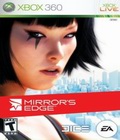Genre: Action/Adventure
Publisher: Electronic Arts
Developer: DICE
Release Date: TBA 2008
The first thing you should know about Mirror's Edge is that if a first-person shooter has ever made you motion-sick, or if you have a crippling fear of heights, this game will hit you like a hammer between the eyes. It is not for you.
For everyone else, Mirror's Edge is about fluidity. It's inspired by the French sport of parkour, treating an urban area like an obstacle course, with controls that fade into invisibility about five minutes after you figure them out. Once you stop stumbling over a new control scheme, you start moving more confidently, and before too long, you can allow suspension of disbelief to take over. The environments are constructed to allow a practiced player to swing, roll, flip, run, and jump through them with elegance and ease.
You play as Faith, a parkour runner employed as a messenger in a clean, Orwellian dystopia, who goes from delivering packages to running from the police. Between the first-person perspective and Faith's lack of superhuman abilities, it's not hard to start feeling like you're in-game, running up walls, awkwardly balancing on narrow ledges, and occasionally kicking a sniper square in the face.
Using a first-person view to achieve this degree of absolute immersion isn't as new an idea as EA thinks it is, but three people played Namco's Breakdown, so they can be forgiven the oversight. It's not something that's done terribly often, either, but it's employed to startlingly vivid effect in Mirror's Edge.
A lot of the game, thankfully, is automated, and the appropriate path through a given level is helpfully labeled in red, preventing you from getting too lost. Three different levels were on display at E3, from an early stage that just challenged you to get from point A to point B, to two later stages that added combat to the mix. Faith's combat skills involve quick takedowns and disarm moves, allowing you to swipe a gun if you like, but the game thrives on running.
You use simple button commands to climb walls or jump, with mantling accomplished automatically when you're close enough to something that Faith can grab. You can also trigger what DICE calls "reaction time" to briefly slow down the action, letting you line up jumps or approach an armed opponent with relative precision.
Honestly, the problem with writing about Mirror's Edge is that you have to see it in action, and ideally play it a bit, to get a feel for it. If you've watched a trailer, you've seen a fair bit of what the game has to offer, but there's a learning curve going on. Balancing on a beam is tricky, and even in the simple introductory level, some of the jumps were surprisingly difficult. This is going to be a game that rewards practice. Don't expect to pick it up and start blowing through it immediately.
Once you have it down, though, Mirror's Edge is fun to watch and to play, like a platformer on steroids. I've been waiting for someone to make a parkour-based video game since I first found out what parkour was, and Mirror's Edge looks like it does the subject material justice. With a little imagination and a lot of skill, it plays like nothing else out there.
More articles about Mirror's Edge











 Mirror's Edge is a revolutionary new take on the First Person Action Adventure category. You are part of an underground group of concerned citizens who, not relying on technology, use runners to relay messages.
Mirror's Edge is a revolutionary new take on the First Person Action Adventure category. You are part of an underground group of concerned citizens who, not relying on technology, use runners to relay messages.


















